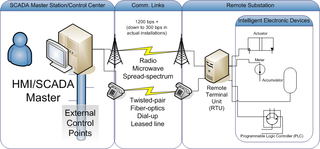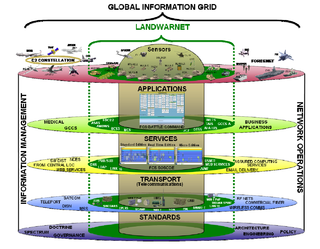Related Research Articles
A learning object is "a collection of content items, practice items, and assessment items that are combined based on a single learning objective". The term is credited to Wayne Hodgins, and dates from a working group in 1994 bearing the name. The concept encompassed by 'Learning Objects' is known by numerous other terms, including: content objects, chunks, educational objects, information objects, intelligent objects, knowledge bits, knowledge objects, learning components, media objects, reusable curriculum components, nuggets, reusable information objects, reusable learning objects, testable reusable units of cognition, training components, and units of learning.

The protocol stack or network stack is an implementation of a computer networking protocol suite or protocol family. Some of these terms are used interchangeably but strictly speaking, the suite is the definition of the communication protocols, and the stack is the software implementation of them.
Interoperability is a characteristic of a product or system, whose interfaces are completely understood, to work with other products or systems, at present or in the future, in either implementation or access, without any restrictions.

A workflow consists of an orchestrated and repeatable pattern of activity, enabled by the systematic organization of resources into processes that transform materials, provide services, or process information. It can be depicted as a sequence of operations, the work of a person or group, the work of an organization of staff, or one or more simple or complex mechanisms.
Software development is the process of conceiving, specifying, designing, programming, documenting, testing, and bug fixing involved in creating and maintaining applications, frameworks, or other software components. Software development is a process of writing and maintaining the source code, but in a broader sense, it includes all that is involved between the conception of the desired software through to the final manifestation of the software, sometimes in a planned and structured process. Therefore, software development may include research, new development, prototyping, modification, reuse, re-engineering, maintenance, or any other activities that result in software products.
In computer science, a software agent is a computer program that acts for a user or other program in a relationship of agency, which derives from the Latin agere : an agreement to act on one's behalf. Such "action on behalf of" implies the authority to decide which, if any, action is appropriate. Agents are colloquially known as bots, from robot. They may be embodied, as when execution is paired with a robot body, or as software such as a chatbot executing on a phone or other computing device. Software agents may be autonomous or work together with other agents or people. Software agents interacting with people may possess human-like qualities such as natural language understanding and speech, personality or embody humanoid form.
The vast majority of the National Security Agency's work on encryption is classified, but from time to time NSA participates in standards processes or otherwise publishes information about its cryptographic algorithms. The NSA has categorized encryption items into four product types, and algorithms into two suites. The following is a brief and incomplete summary of public knowledge about NSA algorithms and protocols.
Kontact is a personal information manager and groupware software suite developed by KDE. It supports calendars, contacts, notes, to-do lists, news, and email. It offers a number of inter-changeable graphical UIs all built on top of a common core.
Enterprise content management (ECM) extends the concept of content management by adding a time line for each content item and possibly enforcing processes for the creation, approval and distribution of them. Systems that implement ECM generally provide a secure repository for managed items, be they analog or digital, that indexes them. They also include one or more methods for importing content to bring new items under management and several presentation methods to make items available for use.

Distributed Network Protocol 3 (DNP3) is a set of communications protocols used between components in process automation systems. Its main use is in utilities such as electric and water companies. Usage in other industries is not common. It was developed for communications between various types of data acquisition and control equipment. It plays a crucial role in SCADA systems, where it is used by SCADA Master Stations, Remote Terminal Units (RTUs), and Intelligent Electronic Devices (IEDs). It is primarily used for communications between a master station and RTUs or IEDs. ICCP, the Inter-Control Center Communications Protocol, is used for inter-master station communications. Competing standards include the older Modbus protocol and the newer IEC 61850 protocol.
A system architecture or systems architecture is the conceptual model that defines the structure, behavior, and more views of a system. An architecture description is a formal description and representation of a system, organized in a way that supports reasoning about the structures and behaviors of the system.
IEC 61508 is an international standard published by the International Electrotechnical Commission consisting of methods on how to apply, design, deploy and maintain automatic protection systems called safety-related systems. It is titled Functional Safety of Electrical/Electronic/Programmable Electronic Safety-related Systems.
The ISO 15926 is a standard for data integration, sharing, exchange, and hand-over between computer systems.
Conceptual interoperability is a concept in simulation theory. However, it is broadly applicable for other model-based information technology domains.
The core idea of Artificial Intelligence systems integration is making individual software components, such as speech synthesizers, interoperable with other components, such as common sense knowledgebases, in order to create larger, broader and more capable A.I. systems. The main methods that have been proposed for integration are message routing, or communication protocols that the software components use to communicate with each other, often through a middleware blackboard system.
System integration is defined in engineering as the process of bringing together the component sub-systems into one system and ensuring that the subsystems function together as a system, and in information technology as the process of linking together different computing systems and software applications physically or functionally, to act as a coordinated whole.

The FCS Network - Brigade Combat Team (BCT) Network consists of five layers that combine to provide seamless delivery of data to forward-deployed Army units.
A specification often refers to a set of documented requirements to be satisfied by a material, design, product, or service. A specification is often a type of technical standard.
Live, Virtual, & Constructive (LVC) Simulation is a broadly used taxonomy for classifying Models and Simulation (M&S). However, categorizing a simulation as a live, virtual, or constructive environment is problematic since there is no clear division between these categories. The degree of human participation in a simulation is infinitely variable, as is the degree of equipment realism. The categorization of simulations also lacks a category for simulated people working real equipment.
Event Processing Technical Society (EPTS) is an inclusive group of organizations and individuals aiming to increase awareness of event processing, foster topics for future standardization, and establish event processing as a separate academic discipline.
References
| This engineering-related article is a stub. You can help Wikipedia by expanding it. |